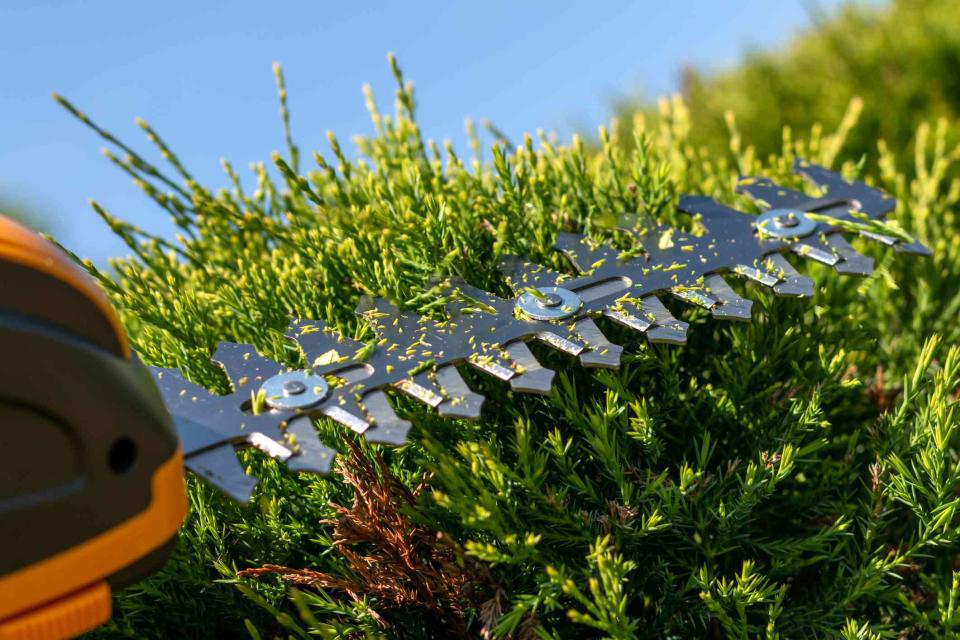How To Clean and Sharpen Hedge Trimmers
Sharpen hedge trimmers safely with these step-by-step directions and tips.

Inna Kozhina / Getty Images
Over time, all blades eventually dull and need to be sharpened for optimal performance. Your hedge trimmers are no different in this respect. Regardless of whether you use them sparingly or often, you’ll need to sharpen them. You can do this one of two ways. The first is taking them to a hardware store and paying to have them sharpened for you. This can get costly, however, and depending on the time of year, can take weeks to get your tool back in hand. The second option is to DIY the task. With a few tools and a little guidance, you can clean and sharpen hedge trimmer blades yourself.
Types of Hedge Trimmers
Let’s start with some basics on hedge trimmers. There are three main types of trimmers: gas powered, electric, and battery-powered. Most often you’ll find gas powered trimmers used by commercial landscape companies, while electric and battery-powered trimmers for home use. Depending on the size of your yard, the thickness of the branches you’ll be cutting, and the amount of money you’re willing to put into a trimmer, you have many options to choose!
Fortunately, all trimmers basically function in the same way. Powered by a motor, hedge trimmers use a thin blade with many wide teeth set against a stationary blade. As the moving blade passes back and forth against the stationary blade, it cuts through vegetation.
:
When to Sharpen Hedge Trimmer Blades
Knowing when to sharpen hedge trimmer blades is not only important for the blades to function properly, but for the motor as well. As with all equipment, you should always consult your hedge trimmer’s manual before you sharpen the blades.
In addition to the normal dulling of blades over time, many hedge plants contain saps, latex, and other sticky substances. These resins begin to gum up the blades and make it more difficult for the motor to pull the blade back and forth, increasing wear on the motor.
While using your trimmer, you might also notice a change in the way it is cutting. As the blade begins to dull, leaves and branches will look shredded instead of cut cleanly. This splintering of woody material will quickly deteriorate the motor and cause damage to plants that can lead to disease.
Step-by-Step Directions for Sharpening Hedge Trimmers
These 5 simple steps will help you effectively sharpen your hedge trimmer blades when they need it.
What You Need
Thick work or gardening gloves
Safety glasses
File
Cloth rag
Whetstone
Thick-bristle brush
Hedge trimmer resin solvent
Step 1: Clean Trimmer Blades
Before you begin sharpening, be sure to clean off the blades of your trimmer. This can be done with a thick-bristle brush or cloth. Remove any dirt or leaves jammed between the blades. Always wear thick gardening gloves when working with blades!
Step 2: Misalign Blades
Next, you need to misalign the blades of the trimmer so that each tooth can be sharpened individually. This will require you to flip the trimmer upside down or rotate, so use caution. A thin piece of wood or screwdriver handle can be used to hold the blades in place while you begin sharpening.
Step 3: File the Teeth
Using your file sharpener, lightly file each tooth toward the cutting edge, only pushing downward, never backwards. Keep the file at the same angle as the edge of the blade and remove the file from the side. Continue until all teeth have been sharpened. Sharpened teeth will once again have shiny silver appearance.
Step 4: Use Whetstone
After teeth are sharpened, use the whetstone on the backside of each tooth to remove any filing “burs” that remain. Always swipe in the direction of the blade to avoid dulling. If you do not have a whetstone, 300 grit sandpaper may also work.
Step 5: Spray Blades with Resin Solvent
The last step will help ensure your hedge trimmer blades last as long as possible. Using a cloth rag to dust off the entire blade and finish by spraying on a coat of hedge trimmer resin solvent and lubricant. The solvent will help keep the blade from rusting and corroding over time. Never use an oil-based solvent on your trimmer blades. Oils can cause damage to plant tissues and are harmful to the environment when not used as directed.
Always store your hedge trimmers and other garden tools in a clean, dry environment. Dust, moisture, and rodents can seriously damage a hedge trimmer over time.
false
